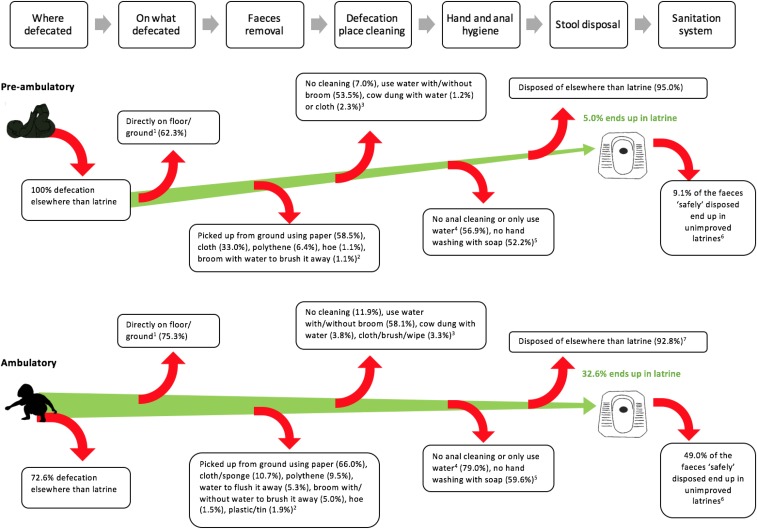Figure 1.
Child feces exposure pathway. 1—if child defecated on ground (N = 151 preambulatory and 364 ambulatory children), that is, on ground in latrine cubicle, on the roadside, on the path near the house, in the household, in the household compound, in a field, by the river, in the bathroom floor. 2—if child defecated elsewhere than latrine, potty, diaper, nappy, bed, drain and if the feces were not left in the open (i.e., not disposed of) and the child defecated directly on the ground (N = 94 preambulatory and 262 ambulatory children). 3—estimated using demonstration data for youngest child (total = 211 preambulatory [four missing] and 483 ambulatory children [three missing]), when the child was reported to defecate on the ground directly of the latrine cubicle, path near the house, in the household, in the household compound, bathroom (N = 86 preambulatory and 210 ambulatory). 4—does the caregiver wash the bottom of the child after defecation, using data on whether youngest child was ambulatory or not (only one response per household) (N = 211 preambulatory and 483 ambulatory children). For three ambulatory children, the caregiver said the child cleans his/her bottom by themselves so there are no data on those children. 5—based on caregivers not washing hands (only two preambulatory), not having a specific place to wash their hands or there being a handwashing facility but with no water and soap, if caregivers demonstrated/reported disposing of their children’s feces (i.e., the question was asked if the feces were not left in the open, or children did not directly defecate in the latrine) (N = 211 preambulatory and 324 ambulatory but data are missing for two preambulatory and two ambulatory children). 6—1/ 11 safely disposed feces of preambulatory feces end up in unimproved latrines, 101/ 206 safely disposed feces of ambulatory children end up in unimproved latrines. 7—if child defecated elsewhere than latrine (N = 458). This figure appears in color at www.ajtmh.org.

